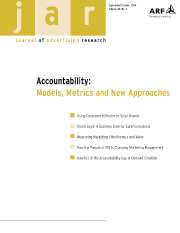Crossref Citations
This article has been cited by the following publications. This list is generated based on data provided by
Crossref.
Channon, Charles
1986.
Research Modes and Management Styles.
International Journal of Advertising,
Vol. 5,
Issue. 2,
p.
161.
Nordfält, Jens
Hjalmarson, Hanna
Öhman, Niclas
and
Julander, Claes-Robert
2004.
Measuring consideration sets through recall or recognition: a comparative study.
Journal of Retailing and Consumer Services,
Vol. 11,
Issue. 5,
p.
321.
Yun Yoo, Chan
and
Kim, Kihan
2005.
Processing of animation in online banner advertising: The roles of cognitive and emotional responses.
Journal of Interactive Marketing,
Vol. 19,
Issue. 4,
p.
18.
Dees, Windy
Bennett, Gregg
and
Tsuji, Yosuke
2006.
Attitudes Toward Sponsorship at a State Sports Festival.
Event Management,
Vol. 10,
Issue. 2,
p.
89.
Osborne, Anne C.
and
Coleman, Renita
2008.
Outdoor Advertising Recall: A Comparison of Newer Technology and Traditional Billboards.
Journal of Current Issues & Research in Advertising,
Vol. 30,
Issue. 1,
p.
13.
Felser, Peter
2008.
Chancen und Gefahren von Werbetests aus Sicht der Praxis.
Marketing Review St. Gallen,
Vol. 25,
Issue. 2,
p.
28.
Jansen, Bernard J.
Zhang, Mimi
and
Schultz, Carsten D.
2009.
Brand and its effect on user perception of search engine performance.
Journal of the American Society for Information Science and Technology,
Vol. 60,
Issue. 8,
p.
1572.
Joo, Ha In
Lee Chong, Kim
and
Yin, Xiang Lan
2009.
Assessing the Effectiveness of Brand Recall, Recognition, and Image of Sponsor and Non-Sponsor in 2008 Beijing Olympic Games: Comparisons of Pre-and Post-Games.
International Area Review,
Vol. 12,
Issue. 3,
p.
3.
Zanjani, Shabnam H. A.
Diamond, William D.
and
Chan, Kwong
2011.
Does Ad-Context Congruity Help Surfers and Information Seekers Remember Ads in Cluttered E-magazines?.
Journal of Advertising,
Vol. 40,
Issue. 4,
p.
67.
Korotkov, Nikolay Y.
2011.
Advertising Pre-Testing in Simulated Test Marketing.
SSRN Electronic Journal,
Goldstein, Daniel G.
McAfee, Randolph Preston
and
Suri, Siddharth
2012.
Improving the effectiveness of time-based display advertising.
p.
639.
Ferrier, Susan
Waite, Kathryn
and
Harrison, Tina
2013.
Sports sponsorship perceptions: An exploration.
Journal of Financial Services Marketing,
Vol. 18,
Issue. 2,
p.
78.
Hartmann, Patrick
Apaolaza, Vanessa
and
Alija, Patxi
2013.
Nature imagery in advertising.
International Journal of Advertising,
Vol. 32,
Issue. 2,
p.
183.
Rokhlenko, Oleg
Golbandi, Nadav
Lempel, Ronny
and
Leibovich, Limor
2013.
Engagement-based user attention distribution on web article pages.
p.
196.
Rajabi, Mahdi
Dens, Nathalie
and
Pelsmacker, Patrick De
2014.
The Handbook of International Advertising Research.
p.
313.
Goldstein, Daniel G.
McAfee, R. Preston
and
Suri, Siddharth
2015.
Improving the Effectiveness of Time-Based Display Advertising.
ACM Transactions on Economics and Computation,
Vol. 3,
Issue. 2,
p.
1.
Überschaer, Anja
Baum, Matthias
Bietz, Bjoern-Thore
and
Kabst, Rüdiger
2016.
The contingencies of person-organization fit perceptions.
Journal of Managerial Psychology,
Vol. 31,
Issue. 6,
p.
1021.
Murphy, Hilary Catherine
and
Chen, Meng-Mei
2016.
Online Information Sources Used in Hotel Bookings.
Journal of Travel Research,
Vol. 55,
Issue. 4,
p.
523.
Baum, Matthias
Schäfer, Marina
and
Kabst, Rüdiger
2016.
Modeling the Impact of Advertisement-Image Congruity on Applicant Attraction.
Human Resource Management,
Vol. 55,
Issue. 1,
p.
7.
Garcia Quintana, Ashley E.
and
Nichols, Cynthia A.
2016.
Code Switching and the Hispanic Consumer.
Hispanic Journal of Behavioral Sciences,
Vol. 38,
Issue. 2,
p.
222.


